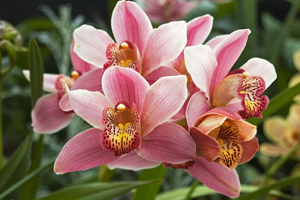You are in : GARDENING » FLOWERING PLANTS » ORCHIDS » Cymbidium Orchid
Cymbidium Orchid
| Scientific Name : Cymbidium |
| Family : Orchidaceae |
| Colour : White, yellow, orange, red, purple |
| Common names : Cymbidiums |
| |
Cymbidiums are the best known and most widely grown of all orchids which will survive in
almost any place. They contain around 44 species, the large flowered types which come from the higher regions of the Himalayas and the Orient require cool conditions to flower well.
These semi-terrestrial orchid have narrow, fleshy,
leathery, strap shaped leaves. These excellent cut flower which last ups to six
weeks, have irregular, waxy, almost translucent petals with entire margins.
Center is often a contrasting color. Flowers are very showy and can be as many as
20-30 blooms or more on a
single spike. The blooms vary in size and this reflects their labeling.
Standard cymbidiums have large flowers of 4 to 5 " width and reach 4-feet
high. Miniature cymbidium varieties produce smaller flowers of 1 to 3 "
width. The blooms come in many different colors like white, yellow, orange, red, purple and even green.
Cymbidiums are not difficult to grow if the needed
requirements are provided to them. It is propagated by rhizome division and are well
grown in bright indirect light. Without enough light many cymbidiums will not
bloom. They prefer open compost of fine orchid bark
with a little humus or course peat mixed in it.. The bark-based compost will
reduce any risk of rotting. Do not allow them to dry-out completely
between watering. Cymbidiums prefer daytime temperatures of 60 to 90 degrees and
40 to 50 degree temperatures at night. They need high humidity. Fertilize them until they are through blooming. When new growth appears,
fertilize with a bloom-booster fertilizer. Simply feed them year round with a
liquid 20-20-20 blend. This should create a plant that grows and blooms very
well. It can be grown outside year round, where the temperatures do not get below freezing. While
they are in bloom, place them in a shaded area because the sun will fade the
pretty blossoms.
Cymbidiums can be repotted every alternate year or more frequently if the plant
has deteriorated due to fungal infections or if rotting has occurred with over watering.
A cymbidium plant may sometimes becomes fairly large and it may be divide or split. However larger the plant, the more flower spikes you can expect.
Questions of
Questions & Answers |
|
| 1. |
Posted on :
2.9.2013 By : Shaleen Chikara , Gurgaon, NCR
|
View Answer (0)
|
Post Answer
|
|
| |
I am growing an Orchid in a small pot filled with charcoal (that's how it came). It was flowering when it came, and now I see 3 new shoots emerging from the sides. How should I care for it and how much should I water it? Also, what is a good potting medium?
I am living in Delhi, and currently it is monsoon season, but soon dry winters will set in. |
|
|
|
|
| 2. |
Posted on :
24.1.2011 By : shruthi , bangalore
|
View Answer (2)
|
Post Answer
|
|
| |
few of my phaelanopsis orchids started to loose the topmost leaf(the blooms were present) and eventually all the leaves fell off.The roots are fine,not dry totally but will the plant grow back? what could be the problem and what do i do? |
|
|
| A1: |
As long as the bulbs are still there and not rotten, it will still grow but takes time to wait for new leaves. |
| |
Posted By :grace de la pena , Cagayan de Oro City, Mindanao | On 9.5.2013 |
|
| A2: |
water got into the center of the plant and rotted must water from the bottom and keep tops dry and no it wont grow back |
| |
Posted By :kevin , las vegas | On 22.2.2011 |
|
|
|
|
| 3. |
Posted on :
5.9.2010 By : Maxine , Spring Hill. Fl, Spring Hill. Fl
|
View Answer (1)
|
Post Answer
|
|
| |
I separated my ground orchid, Spathoglottis plicata this spring as it was over crowed and it has not shown any sige of blooming, What so I need to do to encourage blooming? |
|
|
| A1: |
Hi. I had the same problem. However, I solved it with a bi-weekly watering of a small orchid fertilizer (literally 1/8 of a teaspoon). The water itself was taken from my patio pond. I placed the plant in a high humidity area near other plants. Let the plants drain out completely between waterings. The soil mix comprised real, finely chopped coconut bark, crushed egg shells, charcoal, phosphorus, lumus soil - basically nothing compact. Watch out for mealy bugs as they love these plants. |
| |
Posted By :Paulos , Trinidad | On 15.7.2016 |
|
|
|
|
| » more... |


